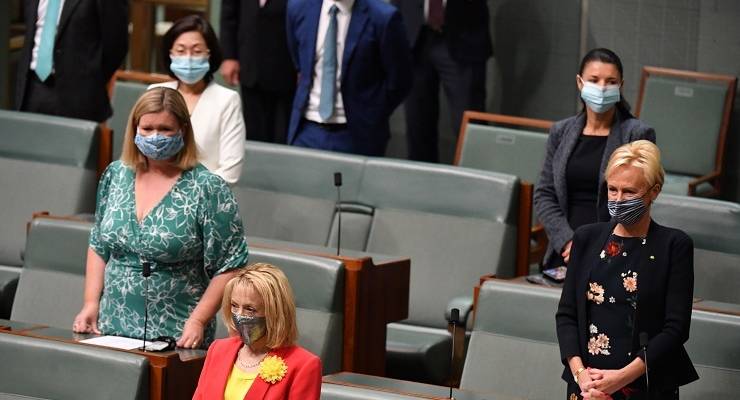
Using targets to achieve gender balance among MPs and senators is a key recommendation of sex discrimination commissioner Kate Jenkins’ scathing review into the toxic culture at Parliament House.
But despite Prime Minister Scott Morrison repeatedly referring to the “multi-party” process required to disrupt the dominance of Parliament’s “boys’ club”, it’s his side of politics that lags well behind on gender parity.
Just a quarter of Liberal MPs across state and federal Parliaments are women.
In federal Parliament, the disparity is particularly stark. Women make up just 23% of the party’s lower house MPs, compared to Labor’s 47%. The party has a target of equal representation among MPs by 2025, which its research admits is unlikely to be achieved.
One solution would be to look seriously at gender quotas, so effective at boosting female representation among Labor’s ranks.
Quotas have long been anathema to the Liberals, at least until March when in the aftermath of a series of sexual assault scandals within its ranks Morrison indicated an openness to quotas. But since then the issue has continued to divide the party.
Who’s in favour of quotas?
Back in March, Morrison repeatedly said he was “very open” to gender quotas in the Liberal Party, acknowledging that its deep opposition to affirmative action wasn’t working. The prime minister would reportedly push the party to adopt quotas. Senior ministers including Marise Payne, Sussan Ley and Karen Andrews were supported quotas. The dial looked like it could be shifting.
But since then there’s been little visible progress. The PM’s office did not respond to questions about whether Morrison supported quotas, or what actions he’d taken to move the dial.
Part of the problem is the deep opposition to quotas within crucial state branches. In New South Wales, for example, former premier Gladys Berejiklian and leading state moderate Matt Kean both supported gender quotas, acknowledging setting targets hadn’t addressed the party’s gender problem.
When Kean tried to take a proposal for quotas to the state executive, influential executive member Alex Dore led the pushback. Several female MPs and senators including Anne Ruston, Fiona Martin and Concetta Fierravanti-Wells joined a “Liberals for Merit” anti-quota campaign.
Elsewhere support is mixed. In Queensland the pushback was led by the LNP’s women’s branch. In Victoria, Opposition Leader Matthew Guy says he’s in favour of turning to quotas if the party fails to preselect enough female candidates for winnable seats.
Preselections fail to boost gender representation
With a federal election right around the corner, we can already gauge just how well the Coalition is likely to boost its female representation. While not all Liberal preselections are finalised, early signs aren’t very encouraging.
So far, only one outgoing male MP has been replaced by a female candidate, with Kristy McSweeney running in the Western Australian seat of Swan. Female candidates overlooked in other preselection battles.
When Bowman MP Andrew Laming quit after a series of harassment allegations, Morrison was keen to nominate a female. Instead, Henry Pike, the only male candidate, won a five-way preselection contest.
Pike was supported by Amanda Stoker, a conservative rising star and Assistant Minister for Women. She was later dropped to the less winnable third spot on the LNP’s Queensland Senate ticket. Stoker claimed it was because her rival, Senator James McGrath, drank more beer with preselectors.
Recently barrister Roshena Campbell, a potential “star candidate”, was snubbed for former political staffer Aaron Violi in the race to represent outgoing speaker Tony Smith’s Melbourne seat of Casey.
Yesterday Morrison pointed to the Liberal Party’s gender targets, and his support for female candidates.
“I’m incredibly encouraged as I’ve been able to get out and about from this building, more recently, to be joining female after female Liberal Party candidate in the seats we are seeking to secure at this election,” he said.
And while there are more preselections still unresolved, the next election probably won’t bring significant progress towards the party’s 50:50 gender target.








I always get a chuckle over the libs fixation with merit in the gender discussion. Casting a cursory glance over the current lib memners and candidates it seems like their main merit is being crooks, or, in the case of James McGrath, drinking beer. Real skill at governing appears to be rare indeed. Putting a few women in the mix, even low meritted ones, would almost certainly improve things.
I’ve always assumed that the definition of merit includes “being a bloke” for LNP purposes.
Is the LNP standard that a woman has to have merit, while a man does not?
But where on earth would they find a woman of merit equal to Richard Colbeck, Stuart Robert, George Christenson etc?
Marise Payne?
Gladys Liu? But she’ll be tossed out at the next election by Max Mok !
https://www.sbs.com.au/chinese/english/hong-kong-democracy-fighter-mounts-campaign-to-unseat-gladys-liu-at-the-next-election
Yes! The disgraceful partner of Stuart Ayres!
Nowhere on this Earth.
Astounding isn’t it? Prime example- Scott Morrison- really not much more than a bumbling idiot. Qualifications? Experience? Brings literally nothing to the job.
I suspect the problem is greater in the LNP than Labor ? So many with the born to rule mentality. A usual precursor to misogynistic behaviour….
It is a greater problem in the the LNP. Labor brought in quotas some time ago and are close to gender parity. The Coalition refuse to do so.
I suppose they can’t have the boys they went to school with missing out on a seat at the trough.
They went to private, all-male schools.
Important coverage for those wanting to make a voting decision in the next 6 months, it all speaks volumes of the parties and people involved. Thanks Kishor.
Firstly, I want equal representation in our parliaments. The world would be a better place, quite obviously.
Secondly, this seems like a coalition problem not a public (voter) problem. As a democracy we have the ability to remove a government without violence. So why don’t we? If ~50% of the population in each electorate are female and this issue is important enough, they shouldn’t be voting for the coalition.
Meanwhile we get stuck in the political spin around quotas, honestly who cares. At some point if you want equal representation you have to vote for it.
Shout out to the amazing female independents we have at all levels of government, getting the job done.
Does Morrison support quotas or has he just recently sniffed the wind. It wasn’t long ago he was opposed:
https://www.sbs.com.au/news/morrison-rejects-gender-quotas-to-boost-female-numbers/7b821d66-8b61-413b-b360-73b8c39309e4
Or is it something he says to make it sound like he is doing something while having no intention of doing anything?
Like everything he spins whilst protecting his posse of crooks (for example, Angus Taylor).
We have a cabinet with the highest number of females ever. Does it make a difference? It’s still the worsts and most corrupt govt in history.
I think women who would want to make a difference will not join or even vote for this party.